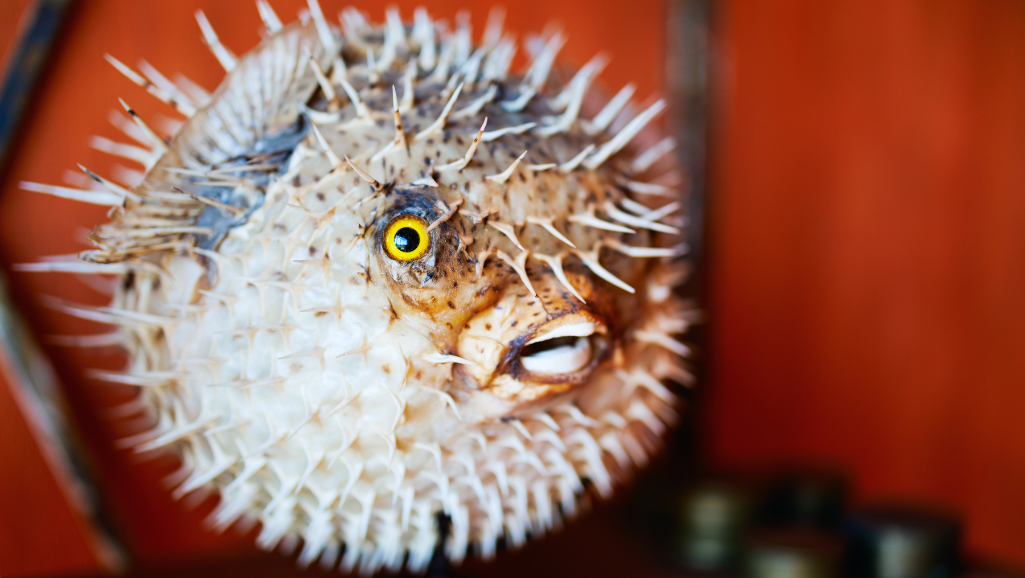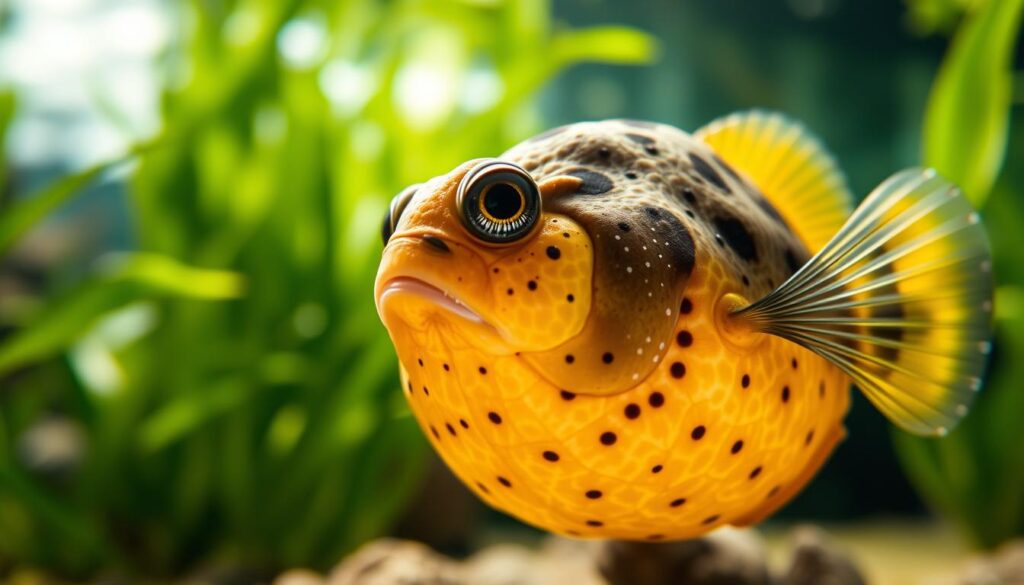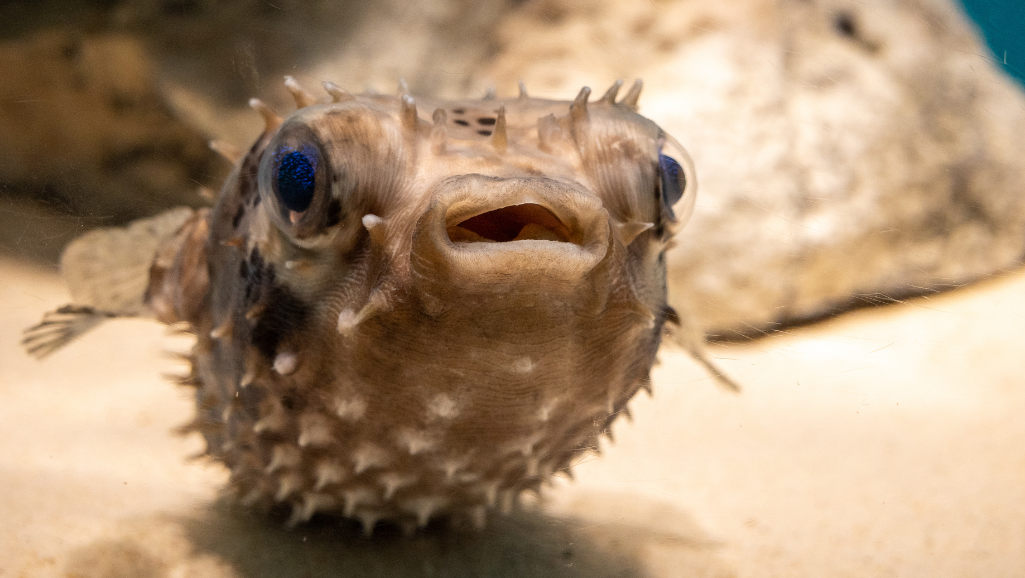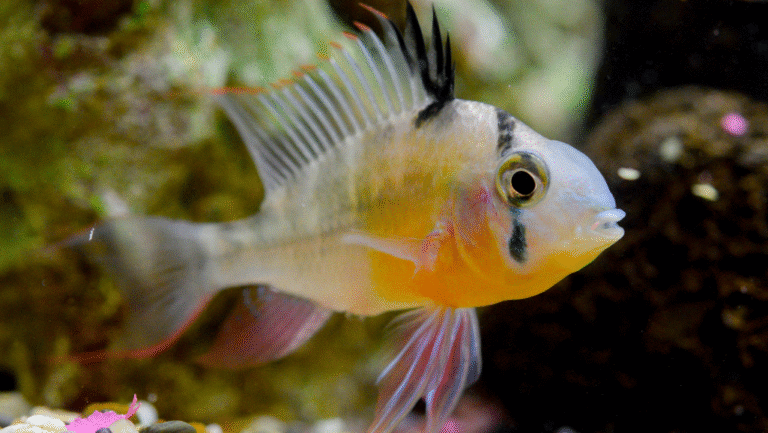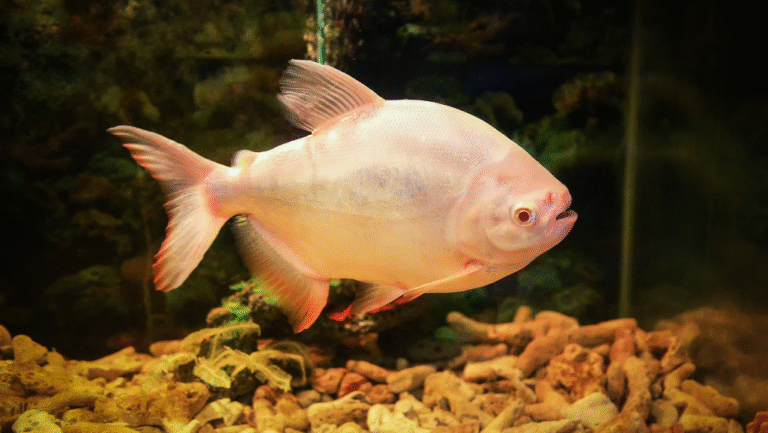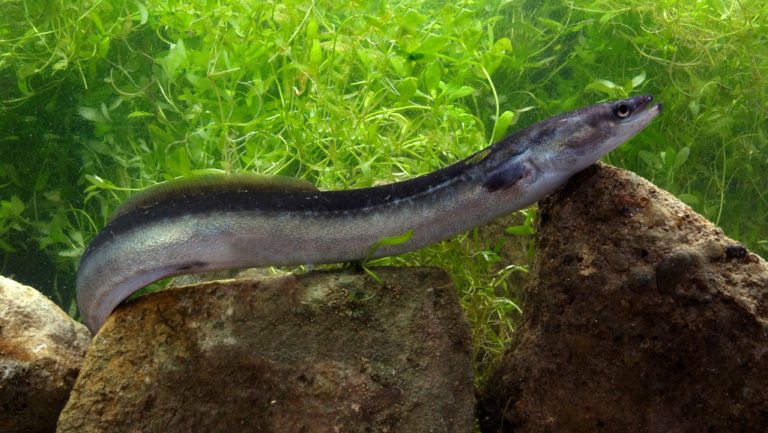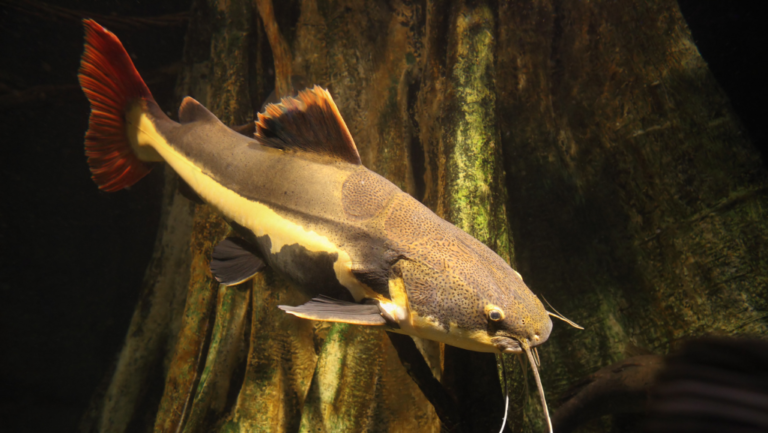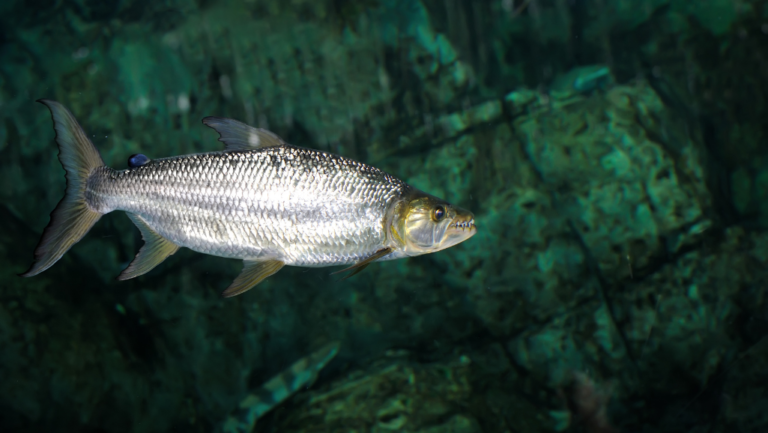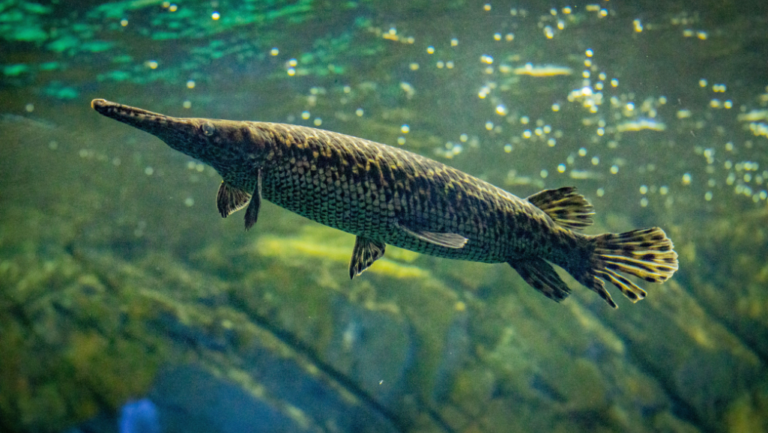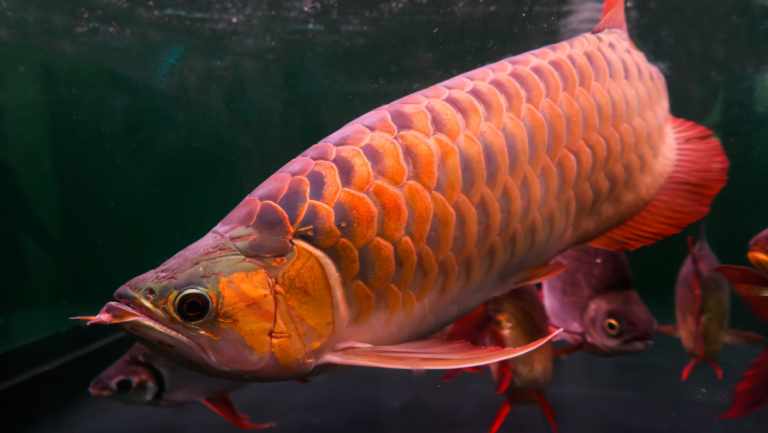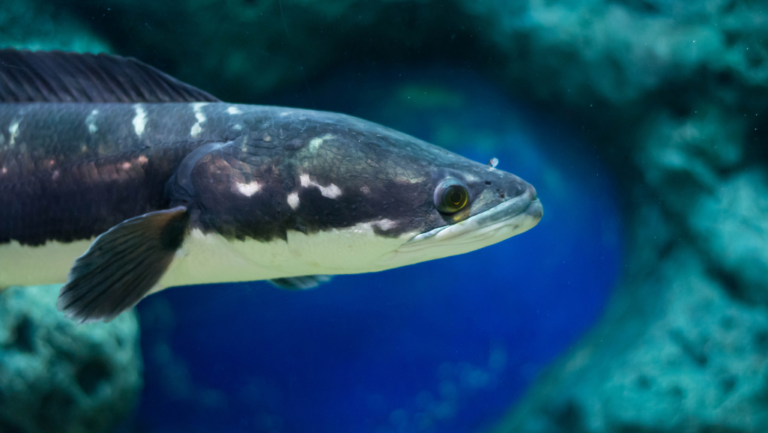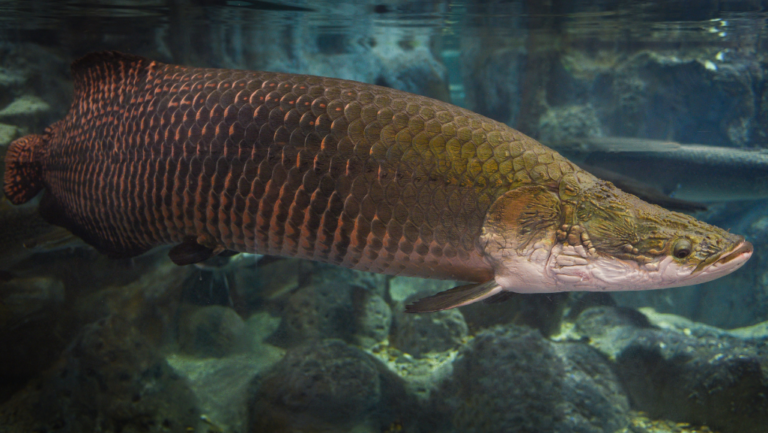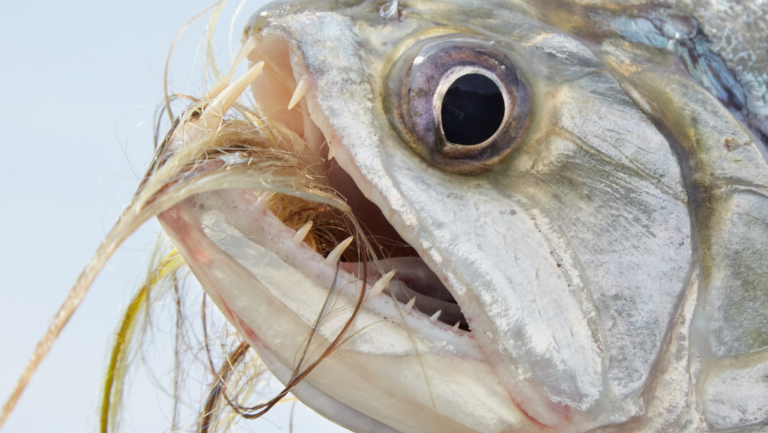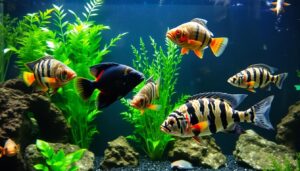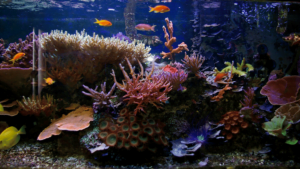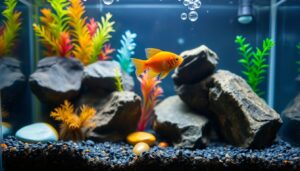Meet a giant of the aquarium world. The mbu puffer (Tetraodon mbu) is a striking freshwater species from the Congo River and the east coast of Lake Tanganyika. Adult fish can reach about 26 inches in the wild and 22–30 inches in captivity, making size and layout top priorities for any serious keeper.
Bold labyrinthine patterns emerge as the fish matures, and its curious eyes and slow, helicopter-like moves give it real personality. Like other puffers, this pufferfish can inflate when startled, so stress reduction matters.
This introduction sets the stage for practical, evidence-based care. We link to a reliable reference for further reading on natural range and biology: Tetraodon mbu overview.
Key Takeaways
- The mbu puffer is a very large freshwater fish that needs a footprint-first tank plan.
- Observe strong filtration, stable water, and a varied diet to prevent tooth issues.
- Decoration should protect the fish: soft sand, sturdy plants, and open swimming space.
- Understanding wild behaviors helps create enriching, low-stress setups.
- Long-term care requires time, resources, and commitment over many years.
Your Mbu Puffer Care Game Plan at a Glance
Start with footprint, not gallons. For a large mbu puffer, plan tank length and front-to-back depth first so a 22–30 inch fish has room to turn and cruise. Treat total gallons as helpful for stability and dilution, not the primary design goal.
Commit to heavy-duty filtration and consistent, preferably automated water changes to handle the waste this species produces. One experienced keeper runs a 72 × 48 × 24-inch (360-gallon) aquarium and swaps roughly 100 gallons daily to keep nitrates near zero.
Match water chemistry to your tap and let shells from clams and mussels gently buffer pH and alkalinity over time. Avoid chasing exact numbers; stability matters more than perfection.
- Stock conservatively: choose peaceful mates and strict feeding protocols to prevent competition during feeding and reduce risks.
- Design for redundancy: battery backups, secure lids, and overflow safeguards protect the system when you can’t be there.
- Document and budget: record behavior and parameters, plan monthly food sourcing (frozen, live), and keep a quarantine plan and cultured feeder strategy ready.
Mbu Puffer Tank Setup and Water Care: Footprint, Filtration, and Stability
Design the tank around movement: a wide footprint matters more than sheer gallons for a giant, cruising freshwater species. Aim for length and front-to-back depth so a 22–30 inch fish can turn and cruise with ease.
Space that fits a giant
Think 7–10 feet long with about 4 feet front-to-back. This layout feels like open water, not a narrow hallway, and lowers stress for a large active fish.
Filtration and waste management
Build filtration for waste load, not rules of thumb. Oversized sumps, multiple canisters, and robust mechanical pre-filters prevent detritus from fouling bio media and reduce nitrate creep.
Daily water changes and buffering
Automate daily water changes (many keepers use ~100 gallons) to control nitrates and dissolved organics. Match pH to your tap and let shells from clams and other foods gently buffer alkalinity near 7.4 for stable chemistry.
Substrate, plants, cycling, and oxygen
Use fine sand and anchor hardy plants like Anubias and Java fern at the back. Avoid sharp décor. Fully cycle before adding the fish: ammonia and nitrite must be zero. Target mid-70s Fahrenheit, favor room heating when practical, and maintain strong surface agitation—oxygen spikes matter after big meals.
- Practical tip: leave wide swim lanes and schedule predictable maintenance so aquarium care stays consistent even when life gets busy.
Feeding and Teeth Health: Diet that builds a stronger beak, not overgrowth
An intelligent feeding plan balances hard shells and soft supplements to protect dental health. For a large mbu puffer or tetraodon mbu, the diet should focus on crunchy, in-shell foods that naturally wear the beak.
Core foods include mussels, clams, cockles, crab claws, squid, and clean, home-raised snails. These items provide the grinding action that keeps teeth at healthy length.
Soft foods and enrichment
Offer shrimp and bloodworms two days per week. Soak soft items in a quality vitamin mix to maintain micronutrients without causing overgrowth.
Snails, live prey, and safe prep
Raise ramshorn or pond snails to avoid pesticides and parasites. Avoid Malaysian trumpet snails—their hard, conical shells can crack teeth.
If you use live crustaceans, quarantine and gut-load them first. Clip one claw from crabs or crayfish to reduce risk to the fish’s eyes.
Frequency, budget, and when teeth go wrong
Many keepers feed shelled foods five days and softer items two days weekly. Expect a substantial food bill—plan for roughly $300 per month for a full-grown individual.
“When diet fails, teeth trimming under sedation becomes a last-resort and carries real risks.”
Watch for trouble: difficulty eating, dropping food, or visible elongation. Rebalance the menu toward shelled options first and consult an experienced aquatic vet before any trimming.
- Rotate mollusks and crustaceans to cover micronutrients and avoid boredom.
- Keep portions regular and log feeding responses to fine-tune the plan over time.
- Leave safe shells in the tank for gentle buffering, and thin excess shells periodically.
Mbu Puffer Behavior, Species Facts, and Safe Handling
Watch how this large species reads the tank: eyes scan independently while short jets of water flip sand and gravel to expose hidden snails and crustaceans. This hunting style rewards a wide, uncluttered aquarium and quiet routines.
Vision, hunting jets, and helicopter-like maneuvering
Directional sight matters. The tetraodon mbu uses independently moving eyes and pectoral fin control to hover like a helicopter, reserving the tail for quick bursts. That precision makes it an expert at locating prey in the substrate.
Puffing, spines, and why air exposure is dangerous during moves
Puffing forces water into the stomach and erects spines as a warning. Never lift this puffer fish out of water with air near the gullet; trapped air during transport can be fatal. Keep moves submerged and calm to avoid this risk.
Toxicity background and why captive diets reduce risk over time
Wild toxin levels come from bacteria in crustacean prey. In captivity, toxin stores decline when diets lack those bacteria, but these fish remain dangerous to predators and never for human consumption. After feeding, oxygen demand rises—boost aeration to support digestion.
- Behavioral cue: partial inflations or focused scanning signal caution, not aggression.
- Handling rule: always move underwater and avoid sudden light or noise.
- Tank care: provide steady aeration and open swim lanes to let hunting behavior unfold safely.
Mbu Puffer Tank Mates and Long-Term Care
Selecting compatible companions and planning for the long haul are the true tests of successful care. Choose calm, nonconfrontational fish that avoid harassing or outcompeting a large predator at feeding time. A wide tank footprint gives everyone room to turn and retreat.
Peaceful companions that work—and those to avoid
Good mates include rasboras, tetras, rainbowfish, fancy guppies, Siamese algae eaters, select plecos, roseline sharks, and Geophagus. These species tend to be fast enough to dodge but not aggressive at the plate.
Avoid persistent pickers and aggressive bottom feeders such as Flagtail Prochilodus or Giraffe Catfish. They stress the pufferfish and can trigger dangerous competition during meals.
Feeding-time hazards, territorial space, and years-long commitment
Manage feeding with intention. Feed the large fish first, then offer small portions to tank mates in different zones. This prevents a chaotic rush that can cause accidental strikes or injury.
Run oversized filtration and schedule regular high-volume water changes to control waste from lots of food and large bodies. Log gallons changed and keep backups for pumps and power outages.
- Keep hardy, anchored plants and wide swim lanes for safe movement.
- Quarantine additions and avoid greedy cleaners that will harass meals.
- Think in years: secure steady food sources and plan upgrades as the fish grows.
Conclusion
,Care for a giant freshwater predator starts with honest planning and steady routines.
If you can offer true space, stable water, and a thoughtful feeding plan, the mbu puffer will repay you with years of presence and personality.
Match the tank footprint to natural behavior, keep filtration and automation reliable, and prioritize crunchy, varied food to protect teeth. Handle the puffer fish only under water to avoid trapped air during moves.
Actionable takeaways: plan the layout, source shelled foods, schedule maintenance, and choose mates conservatively or go species-only. Use these articles and practical steps to build an environment worthy of a remarkable fish.
